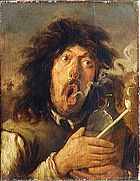
Tronie
Encyclopedia

Dutch Golden Age painting
Dutch Golden Age painting is the painting of the Dutch Golden Age, a period in Dutch history generally spanning the 17th century, during and after the later part of the Eighty Years War for Dutch independence. The new Dutch Republic was the most prosperous nation in Europe, and led European trade,...
and Flemish Baroque painting
Flemish Baroque painting
Flemish Baroque painting is the art produced in the Southern Netherlands between about 1585, when the Dutch Republic was split from the Habsburg Spain regions to the south by the recapturing of Antwerp by the Spanish, until about 1700, when Habsburg authority ended with the death of King Charles II...
that shows an exaggerated facial expression
Facial expression
A facial expression one or more motions or positions of the muscles in the skin. These movements convey the emotional state of the individual to observers. Facial expressions are a form of nonverbal communication. They are a primary means of conveying social information among humans, but also occur...
or a stock character
Stock character
A Stock character is a fictional character based on a common literary or social stereotype. Stock characters rely heavily on cultural types or names for their personality, manner of speech, and other characteristics. In their most general form, stock characters are related to literary archetypes,...
in costume. In contemporary usage the term might cover any picture of an unidentified sitter, but in modern art-historical usage it is typically restricted to figures who do not seem to have been intended to be identifiable, so genre painting
Genre painting
Genre works, also called genre scenes or genre views, are pictorial representations in any of various media that represent scenes or events from everyday life, such as markets, domestic settings, interiors, parties, inn scenes, and street scenes. Such representations may be realistic, imagined, or...
in a portrait format. Typically a painted head or bust only, if concentrating on the facial expression, but often half-length if an exotic costume featured, they might be based on studies from life or use the features of actual sitters. But the image would normally be sold on the art market without identification of the sitter, and would not have been commissioned and retained by the sitter as portrait
Portrait
thumb|250px|right|Portrait of [[Thomas Jefferson]] by [[Rembrandt Peale]], 1805. [[New-York Historical Society]].A portrait is a painting, photograph, sculpture, or other artistic representation of a person, in which the face and its expression is predominant. The intent is to display the likeness,...
s normally were. Similar unidentified figures treated as history painting
History painting
History painting is a genre in painting defined by subject matter rather than an artistic style, depicting a moment in a narrative story, rather than a static subject such as a portrait...
s would normally be given a title from the classical world, for example the Rembrandt painting now known as Saskia as Flora.
Several Rembrandt self-portrait
Self-portrait
A self-portrait is a representation of an artist, drawn, painted, photographed, or sculpted by the artist. Although self-portraits have been made by artists since the earliest times, it is not until the Early Renaissance in the mid 15th century that artists can be frequently identified depicting...
etching
Etching
Etching is the process of using strong acid or mordant to cut into the unprotected parts of a metal surface to create a design in intaglio in the metal...
s are tronies, as are paintings of himself, his son and his women. Three Vermeer paintings were described as "tronies" in the Dissius auction of 1696, perhaps including the Girl with a Pearl Earring
Girl with a Pearl Earring
Girl with a Pearl Earring is a painting by Johannes Vermeer.Girl With a Pearl Earring may also refer to:* Girl with a Pearl Earring , by Tracy Chevalier* Girl with a Pearl Earring...
and the Washington Girl with a flute. Frans Hals
Frans Hals
Frans Hals was a Dutch Golden Age painter. He is notable for his loose painterly brushwork, and helped introduce this lively style of painting into Dutch art. Hals was also instrumental in the evolution of 17th century group portraiture.-Biography:Hals was born in 1580 or 1581, in Antwerp...
also painted a number of tronies, which are now among his best-known works (see gallery).
The tronie is related to, and has some overlap with, the "portrait historié", a portrait of a real person as another, usually historical or mythological, figure. Jan de Bray
Jan de Bray
Jan de Bray , was a Dutch Golden Age painter.-Biography:Jan de Bray was born in Haarlem. According to Houbraken he was the most famous pupil of his father, the architect and poet Salomon de Bray. Houbraken called Jan the "pearl in Haarlem's crown"...
specialised in these, and many portraitists sometimes showed aristocratic ladies in particular as mythological figures.
See also
- Joseph DucreuxJoseph DucreuxJoseph, Baron Ducreux was a French portrait painter, pastelist, miniaturist, and engraver, who was a successful portraitist at the court of Louis XVI of France, and was able to resume his career after the French Revolution...
- French 18th century portraitist whose less formal works use extreme expressions - Franz Xaver MesserschmidtFranz Xaver MesserschmidtFranz Xaver Messerschmidt was a German-Austrian sculptor most famous for his "character heads", a collection of busts with faces contorted in extreme facial expressions.-Early years:...
- Austrian sculptor best known for his extreme "character heads"

